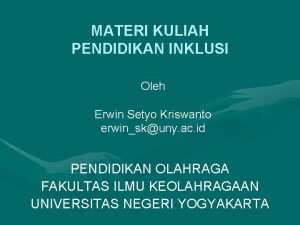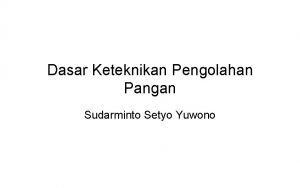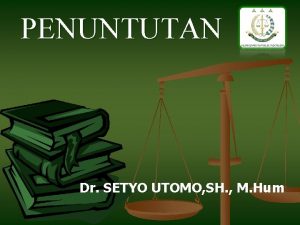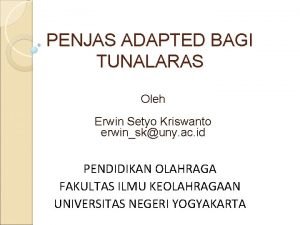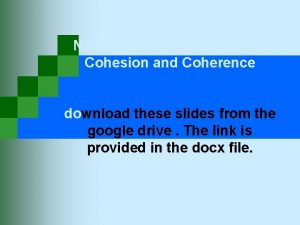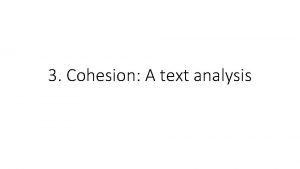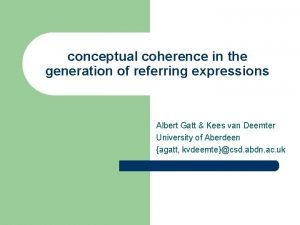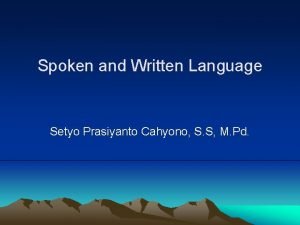TEXT COHERENCE Setyo Prasiyanto Cahyono M Pd TEXT











- Slides: 11

TEXT COHERENCE Setyo Prasiyanto Cahyono, M. Pd.

TEXT COHERENCE Cohesion refers to the internal properties of a text, whereas coherence refers to its contextual properties: that is, the way in which it relates to and makes sense in the situation in which it occurs. In a coherent paragraph, each sentence relates clearly to the topic sentence or controlling idea, but there is more to coherence than this. If a paragraph is coherent, each sentence flows smoothly into the next without obvious shifts or jumps. A coherent paragraph also highlights the ties between old information and new information to make the structure of ideas or arguments clear to the reader.

TEXT COHERENCE Along with the smooth flow of sentences, a paragraph’s coherence may also be related to its length. If you have written a very long paragraph, one that fills a double-spaced typed page, for example, you should check it carefully to see if it should start a new paragraph where the original paragraph wanders from its controlling idea. On the other hand, if a paragraph is very short (only one or two sentences, perhaps), you may need to develop its controlling idea more thoroughly, or combine it with another paragraph. A number of other techniques that you can use to establish coherence in paragraphs are described below. Repeat key words or phrases. Particularly in paragraphs in which you define or identify an important idea theory, or consistent be in how you refer to it. This consistency and repetition will bind the paragraph together and help your reader understand your definition or description.

TEXT COHERENCE Create parallel structures. Parallel structures are created by constructing two or more phrases or sentences that have the same grammatical structure and use the same parts of speech. By creating parallel structures you make your sentences clearer and easier to read. In addition, repeating a pattern in a series of consecutive sentences helps your reader see the connections between ideas. In the paragraph above about scientists and the sense of sight, several sentences in the body of the paragraph have been constructed in a parallel way. The parallel structures (which have been emphasized) help the reader see that the paragraph is organized as a set of examples of a general statement. Be consistent in point of view, verb tense, and number. Consistency in point of view, verb tense, and number is a subtle but important aspect of coherence. If you shift from the more personal "you" to the impersonal “one, ” from past to present tense, or from “a man” to “they, ” for example, you make your paragraph less coherent. Such inconsistencies can also confuse your reader and make your argument more difficult to follow.

TEXT COHERENCE Besides the techniques mentioned above, to make a paragraph coherent, students can employ thematic progression in their paragraph. Thematic progression refers to the way in which the Theme of a clause may pick up or repeat a meaning from a preceding theme and rheme. According to Martin and Rother in Paltridge (2000: 140), there are three kinds of thematic progression patterns, they are: 1. Theme reiteration/constant theme 2. Zig-zag/linear theme pattern 3. Multiple theme/split rheme pattern

THEME REITERATION/CONSTANT THEME This pattern shows that the first theme is picked up and repeated in the beginning of the next clause. This pattern can be seen below: Theme 1 Rheme 1 Theme 2 Rheme 2 Theme 3 Rheme 3 Theme 4 Rheme 4 Theme 5 Rheme 5 ( Martin and Rothery in Paltridge, 2000)

THEME REITERATION/CONSTANT THEME The example of text using this pattern: Li Ping was born in China. He was very interested in learning English, and (he) always tried to find opportunities to speak English with his friends. When he was twelve, he could communicate with his foreign friends freely. Or Whales are facing extinction. The few whales which are left travel along the coastlines of many countries. The whales travel in large groups. Whales are large mammals. They have a layer of skin, blubber, meat, then, their bones.

ZIG-ZAG/LINEAR THEME PATTERN It is a pattern when the subject matter in the rheme of one clause is taken up in theme of the following clause. This pattern can be seen below: Theme 1 Rheme 1 Theme 2 Rheme 2 Theme 3 Rheme 3 Theme 4 Rheme 4 Theme 5 Rheme 5

ZIG-ZAG/LINEAR THEME PATTERN The Example of text using this pattern: Outside my window is a big lawn. In the middle of the lawn is a flower bad. The flower bed is full of roses. The roses are my favourite flowers. Or When Japanese people write their language, they use a combination of two separate alphabets as well as ideogram borrowed from Chinese. The two alphabets are called hiragana and katakana. The Chinese ideograms are called kanji. Hiragana represents the 46 basic sounds that are made in the Japanese language. Katakana represents the same sounds as hiragana but is used mainly for words borrowed from foreign languages and for sound effects. Kanji are used to communicate.

MULTIPLE THEME/SPLIT RHEME PATTERN In this pattern, a rheme may include a number of different pieces of information, each of which may be taken up as theme in a number of subsequent clauses. This pattern can be seen below: Theme 1 Rheme 1 Theme 2 Rheme 2 Theme 3 Rheme 3 Theme 4 Rheme 4 Theme 5 Rheme 5

MULTIPLE THEME/SPLIT RHEME PATTERN The example of text using this pattern: There are four basic types of clowns. Whiteface clowns cover their face with white make-up, and they do a lot of physical stunts like leaping and tumbling. Auguste clowns wear colourful, ill fitting clothing and oversized shoes. They also have bulbous noses and brighly coloured wigs. Character clowns make fun of the human condition and they may impersonate characters such as a cowboy, fireman, tramp or policeman. The more recent “New Vaudeville” clowns involve the audience in the performance.

